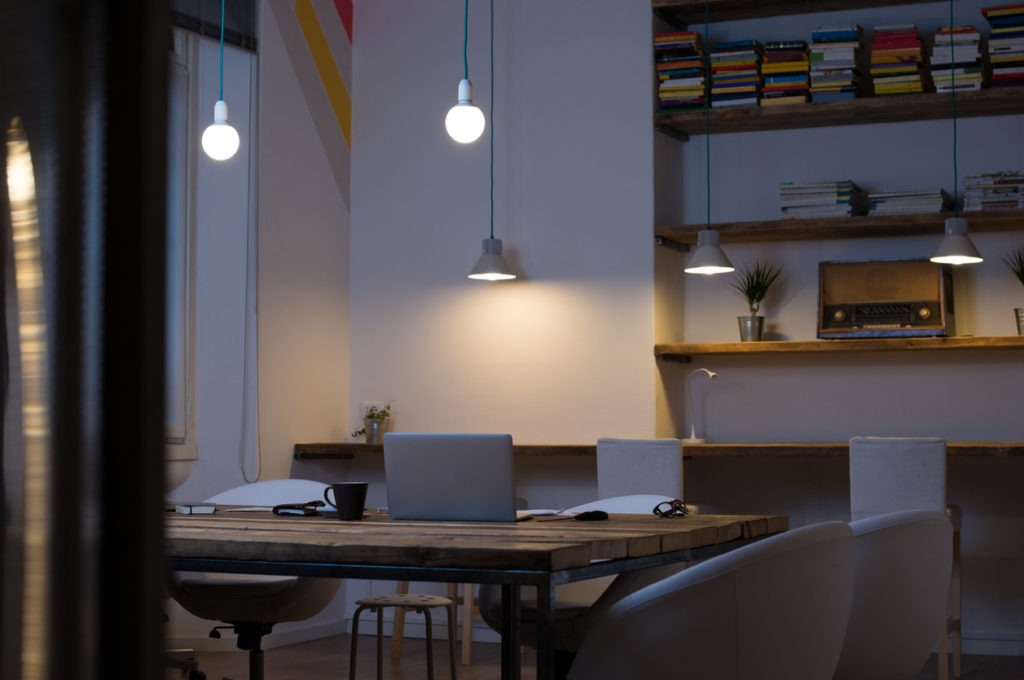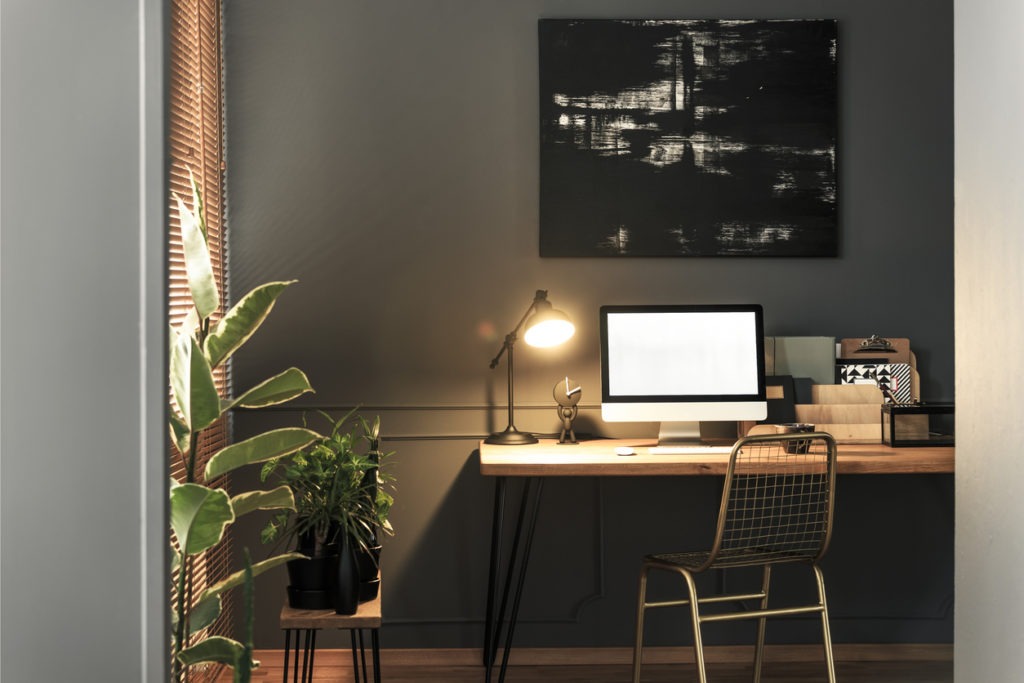There are many factors to consider when designing a home office, and lighting is one of the most important. Proper lighting in a home office is essential for making it a pleasant and productive place to work.
Many individuals now do their job tasks from the comfort of their own homes, sparking renewed attention to home office layout and decor. Also increasing is the need for aesthetically pleasing and functional workplace furniture.
Inadequate lighting in the home office isn’t simply an aesthetic issue; it may also lead to fatigue, headaches, and a decrease in productivity. Adjusting the lighting in your office is a quick and easy way to revitalize the area and increase productivity.
Workspace lighting is especially crucial if you don’t have much natural light coming through. There is a common misconception that overhead or recessed lights, which is common in home offices, are adequate for providing enough illumination for work.
If you’re setting up a home office, here are some tips for illuminating your home office the right way.
Find A Place with Plenty Of Windows
If you already have plenty of light coming into your home office, there is no point in not taking advantage of it. If you’re fortunate enough to have a choice, put your chair in a room with windows to enjoy the natural light. Natural light has numerous advantages over artificial lighting, and looking out at the world may make you feel better. As a bonus, cutting use of artificial lighting will also help you save money on your energy bills.
Indirect Light
Indirect light is ideal for use at a home office desk or workplace. Glare is caused by light reflecting off your screen. Your eyes have to work harder to clearly see the screen in certain lighting situations. Other possible concerns include the following:
- Migraine
- Vision impairment
- Stiff eyes
- Pain in the neck and shoulders due to improper posture
Adjust your desk’s location so that you are working in the brightest area without the light directly hitting the screen. Ergonomic laptop stands and monitors arms may help you get the ideal viewing angle. As a result, you may use natural daylight without having to deal with its potentially damaging glare.
Avoid Working in the Shadows
In addition to bright lights, shadows can also be a source of discomfort for your eyes. Avoid having any sources of erratic lighting near or on your screen. You may need to turn on the overhead bulbs in your home office when night falls and at other times of the day in shadowy areas. Lamps and other auxiliary lighting fixtures can also be helpful.
Intensify Supplementary Lighting
Lack of daylight may disrupt production of hormones necessary for proper sleep, mood regulation, and circadian rhythm. Seasonal Affective Disorder (SAD) is a real possibility. You might want to replace your natural light with a SAD lamp like the Buerer TL20 if you have symptoms of SAD. The advantages of using these “daylight” bulbs, which mimic natural light, become visible after just one or two hours of usage.
Construct Multiple Light Sources
Layers are essential when planning lighting for your home office. Combining several sources of illumination is necessary for adequate lighting of the area. This also allows you to create as much illumination as needed.
Create Lighting for Specific Purposes
With the help of an articulating desk lamp, you may direct the light precisely where it’s needed. In a home office with many workstations, such as a desk for phone and laptop work, a file area, and a desk for analyzing pictures and designs, it is a good idea to have appropriate task-specific lighting at each place.
Consider Trendy Office Lighting
Most home offices will have both general or ambient lighting and more focused task lighting at individual desks or workstations. When designing your home office, don’t stop with task and ambient lighting; consider adding decorative and accent lighting. Mantel and picture bulbs are some examples of accent lighting, while wall sconces are an example of decorative lighting that adds aesthetic appeal to the home office.
Consider Color Temperature
Lighting fixtures in your home office should all have bulbs with the same color temperature, which give a consistent and professional look. Light bulbs with a color temperature between 2700 and 3500 kelvin (k) is warm yellowish, while 3300-5300K is cool, which is suitable for most office settings. 6500K is daylight and too white and bright for an average office.
Choose a bulb that illuminates your desk well without blinding you. The light output of roughly 700 lumens, or anything close to a 60-watt incandescent / 13W LED, should suffice in most situations. However, you might have to install multiple bulbs in order to fully illuminate large spaces and one might not be enough for big rooms.
Types of Lighting
Ambient Lighting
Ambient lighting, often called general lighting, provides enough illumination for people to enter and walk about a space without stumbling. Ceiling and wall sconces are the usual primary sources of ambient lighting. This is the layer on which everything else is built, and most rooms have at least two lighting fixtures designed for this purpose.
However, you should check that the ambient light in your home office provides a highly uniform glow. When you have a good base of ambient lighting that is widely dispersed, you may add different forms of illumination without introducing distractingly deep shadows When feasible, a dimmer switch should be used to control the intensity of lights, which is particularly useful with ambient lighting, which may then be adjusted throughout the day.
Task Lighting
A high-quality task light should be installed anywhere you want to do things like read, write, record videos or do some craft work. Lighting designed specifically for tasks prevents eye strain by casting a narrow beam of light on the area you need to see. Your workstation, reading seats, and other places you spend a lot of time working need this kind of lighting.
Accent Lighting
With accent lighting, you may draw attention to particular objects and design elements. Add an extra layer of accent lighting to your home office to highlight trophies, diplomas, and artwork you want to exhibit.
Types of Lamps for a Home Office
Good lighting in the workplace is aesthetically pleasing, reduces eye strain, and boosts enthusiasm. Maintaining productivity throughout the day, no matter how long, may be accomplished with the proper lighting setup in your home office. Consider alternative lighting arrangements if you’re looking to revamp your home office.
Portable Desk Lamp
Focusing on your job is easier with the help of a work desk lamp that can be moved and adjusted to your liking.
Floor Lamp
Floor lights such as the Brightech Adjustable Pharmacy LED Floor Lamp can help brighten up your workspace with its warm brass finish and attractive contemporary design.
Flexible LED Lighting Tapes
Light-emitting diode (LED) strips provide a source of ambient lighting for the office. You may use them to produce a soft light by placing them around the edge of your desk, along office shelves, or behind your computer display.
Ceiling Track Lights
When creating a productive environment for work, nothing beats a brilliant ceiling light in a home office. It provides enough illumination with movable track heads that may be aimed precisely where they are needed.
Salt Lamp
The warm glow of a Himalayan salt lamp is a popular option. The Himalayan Salt Lamp is one-of-a-kind since it is hand-carved from natural Himalayan salt. The light’s brightness may be adjusted using a dimmer switch to provide the appropriate ambiance, but its main purpose is aesthetics instead of functionality.
Ambient Lighting Controls
If you’re searching for a way to light up your workspace without straining your eyes, check out floor Lamps. The floor lamp’s flat, round head is slanted upward so that its light may reflect off the ceiling and walls. Furthermore, this light fixture’s intensity and color temp may be individually adjusted to meet your specific needs.
Smart Bulbs
The workplace lights may be adjusted remotely with the help of a decent smart bulb. These bulbs allow you to change the color of the light emanating from these bulbs using your smartphone or the accompanying Smart remote.
Portable LED Light
Are you tired of the tangled wires? Choose a light without a cable! The Portable LED Table Lamp is an excellent example of a cordless lamp that delivers enough brightness without adding to the clutter of wires on your desk. These lamps have three different light settings and can stay charged for up to 48 hours.
Why Invest in Good Home Office Lighting?
The quality of the lighting in your workplace is essential for a variety of reasons. Improving the quality of your lighting is an easy way to boost your productivity and make your home office look more professional. It has the added benefit of making your home office an inviting place to spend time. Improper lighting can lead to several issues, some of which are immediate while some can happen in the long term.
- Migraines and eye fatigue
- Possibility of having slips, trips, and falls
- Mental health effects
- Lower efficiency and productivity
FAQs
What kinds of bulbs are recommended for a home office?
The commonly used bulbs are incandescent, LEDs, CFLs and Halogen bulbs. The most practical option is to switch to LED as they are energy efficient and produce the most light per watt. They are more efficient than regular bulbs and can cover a wider area, making them perfect for workplaces, kitchens, corridors, and garages. Light from LED bulbs uses roughly 75% less power than regular lights, and rooms stay cooler as a result.
Can workplace lighting be too vivid?
Eyestrain, weariness, and headaches from inadequate workplace lighting may make concentrating on work difficult. This can negatively influence our everyday emotions, leading to poorer efficiency and absent-mindedness. An overly lit office environment is also not desirable as it disturbs our sleep cycle and sense of time.
How bright should a desk lamp be?
The white or cool white light emitted by an LED desk lamp with a color temperature between 3300K and 5300K is vivid enough and comfortable to use for extended periods, but some people also like warmer temperatures for a cozier feel. 6500K and anything above is daylight and should be avoided especially at night. A 13W LED bulb produces around 800 lumens and is reasonable enough for small rooms. You can either install multiple such bulbs in a large room or consider a LED bulb with a higher wattage to properly illuminate large spaces.
Conclusion
When setting up a home office for the first time, it might take some time to find suitable lighting bulbs without the help of an expert. Given that everyone has unique tastes and wants, one person’s ideal lighting arrangement may not be the greatest for everyone. If your lighting may need some tweaking, keep in mind that adding or removing lights and switching out light bulbs to experiment with different tones and intensities is simple and everyone can do that.


